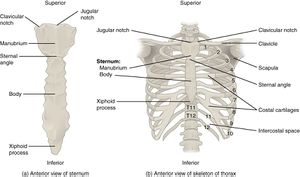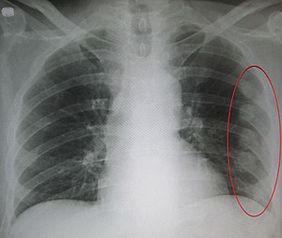Flail Chest: Difference between revisions
Sonal Joshi (talk | contribs) (Resource link which is no longer active was removed) |
Sonal Joshi (talk | contribs) (Added new reference) |
||
| Line 6: | Line 6: | ||
== Introduction == | == Introduction == | ||
[[File:Rib Cage.jpg|right|frameless]] | [[File:Rib Cage.jpg|right|frameless]] | ||
A flail chest | A flail chest is described when a segment of the rib cage breaks due to blunt thoracic trauma, high speed motor vehicle crash and becomes unattached from the chest wall.<ref>Pettiford BL, Luketich JD, Landreneau RJ. [https://www.sciencedirect.com/science/article/abs/pii/S1547412707000072 The management of flail chest]. Thoracic surgery clinics. 2007 Feb 1;17(1):25-33.</ref>It can occur when 3 or more [[ribs]] are broken in at least two places, although not everyone with this type of injury will develop a flail chest. However, when these injuries cause a segment of the chest to move independently, the generation of negative intrapleural pressure indicates a true paradoxical flail segment<ref name=":0">May L, Hillermann C, Patil S. [https://academic.oup.com/bjaed/article/16/1/26/2463139 Rib fracture management]. Bja Education. 2016 Jan 1;16(1):26-32.</ref>. This condition is of clinical significance in elderly patients or patients who have chronic [[COPD (Chronic Obstructive Pulmonary Disease)|lung disease]], associated with morbidity and mortality. | ||
== Pathophysiology == | == Pathophysiology == | ||
This pathology of rib fracture associated with | This pathology of rib fracture is associated with decreased chest movement due to pain. This furthur reduces the tidal volume and may predispose to significant [[atelectasis]], impaired gas exchange in the affected lung beneath the fractured rib, altered in breathing mechanism. All these contributing factors may lead to [[pneumonia]], pulmonary secretion retention and paradoxical chest movement.<ref name=":0" /> | ||
{{#ev:youtube|aeOzrwf6y5M|300}}<ref>The First Aid Show. Flail Chest. Available from: http://www.youtube.com/watch?v=aeOzrwf6y5M[last accessed 4/4/2020]</ref> | {{#ev:youtube|aeOzrwf6y5M|300}}<ref>The First Aid Show. Flail Chest. Available from: http://www.youtube.com/watch?v=aeOzrwf6y5M[last accessed 4/4/2020]</ref> | ||
| Line 93: | Line 93: | ||
** Early mobilization if possible<ref name=":0" /> to prevent contracture and loss of muscle mass | ** Early mobilization if possible<ref name=":0" /> to prevent contracture and loss of muscle mass | ||
** Transfers to sitting out of bed | ** Transfers to sitting out of bed | ||
** Mobilization 2-3 times daily and | ** Mobilization 2-3 times daily and sitting out of bed 3-4 time/day | ||
* Chest and airway clearance techniques (if inadequate) | * Chest and airway clearance techniques (if inadequate) | ||
** ACT: nebulizer with [[Active Cycle of Breathing Technique|ACBT]] and education | ** ACT: nebulizer with [[Active Cycle of Breathing Technique|ACBT]] and education | ||
| Line 103: | Line 103: | ||
** Positioning in side lying and high sitting | ** Positioning in side lying and high sitting | ||
It was recommended to apply chest physiotherapy after adequate pain relief modalities<ref name=":2" /> | It was recommended to apply chest physiotherapy after adequate pain relief modalities<ref name=":2" /> | ||
A study<ref>Mohamed HG, Ragab EI, Bary MA, Elshazly M, Latif AF. The Impact of Chest Physiotherapy Technique (CPT) on Respiration, Pain and Quality of Life Post Thoracic Wall Fixation Surgery among Flail Chest Patients (FC). American Journal of Nursing. 2018 Oct 31;6(6):471-83.</ref> done in 2018 in Egypt in patients with flail chest referred for chest physiotherapy showed improved QOL on 1st, 3rd and 6th month follow up of starting the treatment. It included an exercise protocol of, | |||
# Diaphragmatic exercise | |||
# Coughing exercise | |||
# Intermittent pressure breathing | |||
# Secretion mobilization techniques(percussion, vibration & incentive spirometry) | |||
== Resources == | == Resources == | ||
| Line 110: | Line 117: | ||
== References == | == References == | ||
<references /> | <references /> | ||
[[Category:Acute Care]] | [[Category:Acute Care]] | ||
[[Category:Respiratory]] | [[Category:Respiratory]] | ||
[[Category:Cardiopulmonary]] | [[Category:Cardiopulmonary]] | ||
[[Category:Acute Respiratory Disorders - Conditions]] | [[Category:Acute Respiratory Disorders - Conditions]] | ||
Revision as of 07:00, 13 December 2022
Introduction[edit | edit source]
A flail chest is described when a segment of the rib cage breaks due to blunt thoracic trauma, high speed motor vehicle crash and becomes unattached from the chest wall.[1]It can occur when 3 or more ribs are broken in at least two places, although not everyone with this type of injury will develop a flail chest. However, when these injuries cause a segment of the chest to move independently, the generation of negative intrapleural pressure indicates a true paradoxical flail segment[2]. This condition is of clinical significance in elderly patients or patients who have chronic lung disease, associated with morbidity and mortality.
Pathophysiology[edit | edit source]
This pathology of rib fracture is associated with decreased chest movement due to pain. This furthur reduces the tidal volume and may predispose to significant atelectasis, impaired gas exchange in the affected lung beneath the fractured rib, altered in breathing mechanism. All these contributing factors may lead to pneumonia, pulmonary secretion retention and paradoxical chest movement.[2]
Types[edit | edit source]
- Complete
- Incomplete
- Physeal
Classification according to the nature of the fracture:
- Spiral
- Transverse
- Comminuted
- Compression
Associated Conditions[edit | edit source]
Pulmonary complications 48-72 hours after admission[4]:
- Haemothorax
- Pneumothorax
- Atelectasis
- Pneumonia
- Pleural effusion
- Subcutaneous emphysema
- ARDS (Acute Respiratory Distress Syndrome)
- Pulmonary emboli
- Aspiration
- Lobar collapse
Risk factors for developing associated conditions[4]:
- Patient >65 years old
- rib fractures >3 ribs
- History of chronic lung conditions or CVD
- Pre-injury anti-coagulant use
- SpO2 <90%
Clinical Presentation[edit | edit source]
The clinical presentation depends on the severity of the impact, size of the flail segment and to what extent lung affected.[5]The patient may complain of severe chest wall pain and may have tachypnea. On close observation there may be paradoxical chest wall movement. On inspiration the flail segment will move inwards whilst the rest of the chest expands and on expiration the flail segment will move outwards whilst the rest of the chest contracts.
If the patient is mechanically ventilated or on Bilevel Positive Airway Pressure (BiPAP) it may be difficult to diagnose and may only become obvious after extubation.
Diagnostic Procedures[edit | edit source]
An abnormal chest movement during breathing may be a sign of flail chest.
Radiologists use Chest X-Rays to look for the following:
“Three or more adjacent ribs are fractured in two or more places. Clinically this can be a segment of only one or two ribs can act as a flail segment”
CT is more accurate modality in severe blunt trauma.
Outcome Measures[edit | edit source]
Medical Management[edit | edit source]
Medications[edit | edit source]
- Simple Analgesics[2]
- Opioids like morphin when pain is not controlled with simple analgesics
- Patient Controlled Analgesia
- Operative fixation and Regional Anaesthetic
Surgery[edit | edit source]
- Regional anesthesia
- Serratus anterior block
- Paravertebral block
- Thoracic epidural
Internal Fixation[edit | edit source]
- It is a difficult and challenging procedure due to the nature of the rib.
- Decreases stay in ICU and MV duration.
- Incision site is Similar to thoracotomy and the latissmus dorsi muscle wasn't incised.
- Anterior fracture- plates and locking screws
- Posterior fracture - intramedullary splints
Physiotherapy Management[edit | edit source]
Role of chest physiotherapy for inpatient care depend on secretion clearance to prevent respiratory infection, restore normal lung volume, pulmonary function. There's still little information about physical therapy role after discharge from the hospital.
Management consists of the following:
- Ventilatory Management - supplemental oxygen therapy, continuous positive airway pressure or intubation if necessary[2]
- CPAP - for negative intrapleural pressure and paradoxical movement, increases TV
- Open/closed suction if patient intubated.
- Pain Management and Education
- Education on fracture healing
- Early mobilization if possible[2] to prevent contracture and loss of muscle mass
- Transfers to sitting out of bed
- Mobilization 2-3 times daily and sitting out of bed 3-4 time/day
- Chest and airway clearance techniques (if inadequate)
- ACT: nebulizer with ACBT and education
- Bubble PEP or Flutter
- Deep breathing exercises and supported coughing technique
- Supported Cough: Wrap around technique or rolled up towel
- DBE/TEE’s with SMIs (2-4 secs hold)
- Positioning[6]
- Positioning in side lying and high sitting
It was recommended to apply chest physiotherapy after adequate pain relief modalities[5]
A study[7] done in 2018 in Egypt in patients with flail chest referred for chest physiotherapy showed improved QOL on 1st, 3rd and 6th month follow up of starting the treatment. It included an exercise protocol of,
- Diaphragmatic exercise
- Coughing exercise
- Intermittent pressure breathing
- Secretion mobilization techniques(percussion, vibration & incentive spirometry)
Resources[edit | edit source]
www.rch.org.au/trauma service/manual/chest-injury
radiopaedia.org articles, flail-chest
References[edit | edit source]
- ↑ Pettiford BL, Luketich JD, Landreneau RJ. The management of flail chest. Thoracic surgery clinics. 2007 Feb 1;17(1):25-33.
- ↑ 2.0 2.1 2.2 2.3 2.4 May L, Hillermann C, Patil S. Rib fracture management. Bja Education. 2016 Jan 1;16(1):26-32.
- ↑ The First Aid Show. Flail Chest. Available from: http://www.youtube.com/watch?v=aeOzrwf6y5M[last accessed 4/4/2020]
- ↑ 4.0 4.1 Battle C, Hutchings H, Evans PA. Blunt chest wall trauma: a review. Trauma. 2013 Apr;15(2):156-75.
- ↑ 5.0 5.1 Jena RK, Agrawal A, Sandeep Y, Shrikhande NN. Understanding of flail chest injuries and concepts in management. International Journal of Students’ Research. 2016 Jan 1;6(1):3.
- ↑ Berney S, Haines K, Denehy L. Physiotherapy in critical care in Australia. Cardiopulmonary physical therapy journal. 2012 Mar;23(1):19.
- ↑ Mohamed HG, Ragab EI, Bary MA, Elshazly M, Latif AF. The Impact of Chest Physiotherapy Technique (CPT) on Respiration, Pain and Quality of Life Post Thoracic Wall Fixation Surgery among Flail Chest Patients (FC). American Journal of Nursing. 2018 Oct 31;6(6):471-83.








